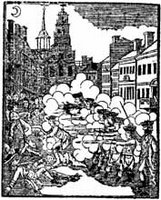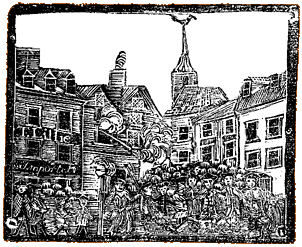 Yesterday I quoted
Yesterday I quoted how a
recent study of
George Washington’s military experiences depicted him introducing himself to the
Continental Army troops at
Cambridge by reading the 101st Psalm from his psalm-book. I traced that unsourced anecdote back to a
biography of Washington’s predecessor,
Artemas Ward, which presented it with unmistakable skepticism. (I also couldn’t resist quoting another historian who called the tale “the maunderings of a nonagenarian”; we just don’t see that sort of language in scholarship anymore.)
That biography of Ward in turn cited an earlier source as the first print appearance of this tale: Daniel F. Secomb’s
History of the Town of Amherst, Hillsborough County, New Hampshire, published in 1883.
Secomb (1820-1895) wrote: Capt. [Josiah] Crosby’s company was present when Washington took command of the army, 2 July, 1775, of which Andrew Leavitt, one of the survivors, gave the following account to the writer many years since: The officers placed their men in as good shape as they could, but they were a motley looking set, no two dressed alike. Some were armed with fowling pieces, some with rifles, others with muskets without bayonets. When all was in readiness, Washington and his staff advanced to the square prepared for their reception. He was a large, noble looking man, in the prime of life, and was mounted on a powerful black horse over which he seemed to have perfect control.
After a short address to the soldiers, he took from his pocket a Psalm book, from which he read the one hundred and first Psalm (another account says it was then sung by the soldiers to the tune of Old Hundred).
There are some historical glitches here. Washington reviewed troops at Cambridge on 3 July, not 2 July. “Rifles” were very rare, possibly non-existent, in the New England army in mid-1775. But we might expect such discrepancies to crop up after many years.
And it
was many years—about half a century—between Washington’s arrival at Cambridge and when Secomb was old enough to have heard that story from Leavitt. There were also at least thirty-seven years between the last time Leavitt could have told the story, given his death in 1846, and Secomb’s publication. The phrase “many years since” shows that Secomb actually didn’t remember how long it had been.
George Allen Ramsdell’s
History of Milford, New Hampshire, published in 1901, offers a parallel statement with a little more information:
Andrew Leavitt, at this time of Amherst, but a member of Captain Crosby’s company, repeatedly stated in his lifetime that after Washington had made a short address he read the one hundred and first Psalm. There is a tradition in the Wallace family, then represented by the soldier, Joseph Wallace, that when Washington had finished reading the psalm the company took up the matter and sang or chanted it to an appropriate tune.
Ramsdell (1834-1900, shown above courtesy of the
Milford Historical Society) was a native of Milford, where most of Crosby’s company came from. He seems to have relied on family and local traditions rather than hearing the two veterans themselves, and probably also knew of Secomb’s book.
Documents from 1775 confirm that Andrew Leavitt and “Joseph Wallis” were members of Crosby’s company as early as June. There’s no contemporaneous record that their company was on the parade when Washington (and Gen.
Charles Lee) first reviewed troops in Cambridge, nor have I found any evidence to contradict that belief. As twentieth-century scholars have pointed out, the army didn’t make that much of Washington’s arrival in 1775, so there’s very little documentation about it.
I think the biggest problem with accepting Secomb’s apparent quotation as a reliable first-person account of a Revolutionary event lies in the words themselves. A veteran describing an event he had personally witnessed would not have added, “another account says...,” at least not without stating whether that rival account squared with his own recollection. Indeed, what Secomb presented as Leavitt’s story is notable for being entirely in the third person: it calls the soldiers “they” instead of “we.” Rather than treat those paragraphs as a direct quotation from Andrew Leavitt, I think we must take these words as Secomb’s own description, written “many years” later, of what he recalled hearing Leavitt describe to him as a child or youth, along with Secomb’s note on “another account” he had heard.
This anecdote is therefore equivalent to us now learning new details about a notable public event involving hundreds of people in 1899, and a very notable public personage, based on a secondhand account committed to paper years after the storytelling. Those details have never been in the record before, are based on oral transmission and memory, and conform to many people’s beliefs about how the past
should be. I think the account therefore needs strong supporting evidence to be credible.
One possible source for such support would be Leavitt’s pension application, if one survives. In 1840, at the age of 87, Leavitt was
receiving a federal pension while living in the home of his son William. To receive that pension, he would have filed a deposition with the federal government, relating his Revolutionary War experiences with notable memories to add verisimilitude to an otherwise bald and unconvincing narrative. Did Leavitt describe parading for the new commander-in-chief when he applied for a pension, perhaps half a century before Secomb wrote? Did he then describe Washington reading the 101st Psalm?
Otherwise, we’re in the difficult position of assessing the authenticity of oral traditions. According to Ramsdell, people remembered Andrew Leavitt telling his story on multiple occasions. Another family in a nearby town told a similar (though not identical) story. Those traditions may not really be independent of each other, but they do strengthen each other; I think it would be unlikely for two families to come up with such similar tales without a common source.
TOMORROW: A common source—in popular fiction? [ADDENDUM:
Change of plans.]







